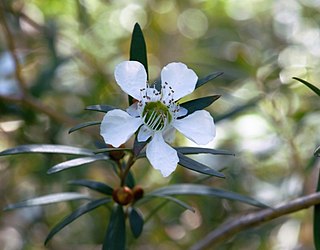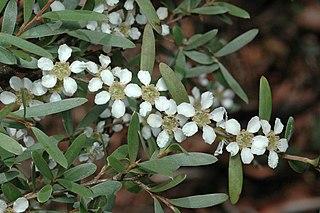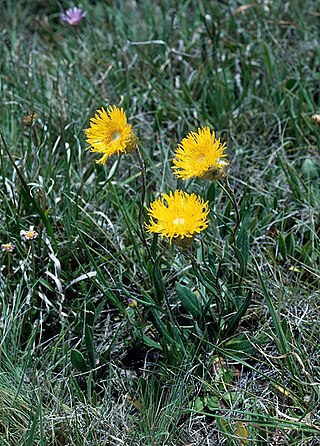
Swainsona galegifolia commonly known as smooth Darling pea, is a species of flowering plant in the family Fabaceae and is endemic to Australia. It is a small shrub with greyish-green leaves and flowers in white, red, pink, purple, yellow or orange.

Leptospermum laevigatum, commonly known as the coast tea tree, is a species of shrub or small tree that is endemic to south-eastern Australia, but has been widely introduced in other places where it is often considered to be a weed. It has thin, rough bark on the older stems, narrow egg-shaped leaves, relatively large white flowers and flat topped fruit that is shed shortly after reaching maturity.

Podolobium alpestre, commonly known as alpine shaggy-pea, is a flowering plant in the family Fabaceae and is endemic to south-eastern Australia. It has oblong to egg-shaped leaves and yellow to orange pea-like flowers with red markings.

Goodenia hederacea, commonly known as forest goodenia or ivy goodenia, is a species of flowering plant that is endemic to eastern Australia. It is a prostrate to ascending, perennial herb with linear to elliptic or round leaves, and racemes of yellow flowers.

Pultenaea juniperina, commonly known as prickly bush-pea or prickly beauty is a species of flowering plant in the family Fabaceae and is endemic to south-eastern Australia. It is an erect, spiky shrub with hairy stems, linear to narrow elliptic leaves with stipules at the base, and yellow-orange and red flowers.

Ozothamnus alpinus, commonly known as alpine everlasting, is a flowering plant in the family Asteraceae. It is endemic to alpine and subalpine areas in south-eastern continental Australia.

Leptospermum morrisonii is a shrub or small tree that is endemic to New South Wales. It has strongly aromatic, elliptical to lance-shaped or curved leaves, white or greenish white flowers and fruit that remain on the plant. It occurs in the south-east of the state.

Leptospermum obovatum, commonly known as river teatree, is a species of shrub that is endemic to south-eastern continental Australia. It has egg-shaped or lance-shaped leaves that are narrower at the base, white flowers usually arranged singly on short side shoots and fruit that remains on the plant until it dies.

Persoonia brevifolia is a plant in the family Proteaceae and is endemic to a restricted area near the border between south-eastern New South Wales and Victoria. It is an erect shrub with elliptic to egg-shaped leaves and cylindrical yellow flowers arranged singly in leaf axils.

Pultenaea blakelyi, commonly known as Blakely's bush-pea, is a species of flowering plant in the family Fabaceae and is endemic to south-eastern continental Australia. It is an erect shrub with sharply-pointed, narrow elliptic to egg-shaped leaves and yellow to orange flowers in open clusters in leaf axils or at the ends of branches.

Leptospermum argenteum, commonly known as the Mt Royal tea-tree, is a species of shrub that is endemic to the higher parts of Barrington Tops in New South Wales. It has smooth bark, stems with a flange along the sides, broad leaves, white flowers and unlike many others in the genus, it is never lemon-scented.

Leptospermum brevipes, commonly known as the slender tea-tree, is a species of shrub or small tree that is endemic to eastern Australia. It has fibrous bark on the main stems, smooth bark on young stems, narrow elliptical to narrow egg-shaped leaves, white flowers and hemispherical fruit that is shed when mature.

Leptospermum polyanthum is a rigid, spreading shrub or small tree that is endemic to New South Wales. It has thin, rough bark, young stems that are hairy at first, elliptical leaves, relatively small white flowers and fruit are shed when the seeds are mature.

Leptospermum rupicola is a low-growing shrub that is endemic to New South Wales where it grows near cliffs. It has thin, rough bark, narrow lance-shaped leaves, white flowers and relatively large fruit that remain on the plant at maturity.

Brachyscome nivalis, commonly known as snow daisy, is a perennial herb in the family Asteraceae and is endemic to Australia. It has mostly white daisy-like flowers, yellow centres and deeply lobed leaves.

Goodenia bellidifolia, commonly known as daisy goodenia, is a species of flowering plant in the family Goodeniaceae and is endemic to eastern Australia. It is an erect, perennial herb with egg-shaped to lance-shaped leaves with the narrower end towards the base, spikes or thyrses of lemon-yellow to orange flowers, and oval to more or less spherical fruit.

Goodenia pusilliflora, commonly known as small-flower goodenia, is a species of flowering plant in the family Goodeniaceae and is endemic to drier parts of southern Australia. It is a low-lying to ascending herb with oblong to egg-shaped leaves with toothed or lyrate edges, and racemes of small yellow flowers.

Pultenaea largiflorens, commonly known as twiggy bush-pea, is a species of flowering plant in the family Fabaceae and is endemic to south-eastern continental Australia. It is a rigid, erect shrub with narrow egg-shaped leaves with the narrower end towards the base, and bright yellow and crimson flowers.

Calotis lappulacea, commonly known as the yellow burr-daisy, is a flowering plant in the family Asteraceae found in many parts of mainland Australia. It is a small, perennial herb with yellow globular flower-heads.

Podolepis decipiens, commonly known as deceiving copperwire-daisy, is a flowering plant in the family Asteraceae and grows in Victoria, Tasmania and New South Wales. It is an upright, perennial herb with yellow daisy-like flowers on a single stem rising from a sparse rosette.




















